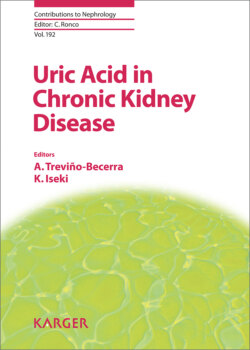Читать книгу Uric Acid in Chronic Kidney Disease - Группа авторов - Страница 16
На сайте Литреса книга снята с продажи.
Pathogenic Role of Uric Acid Renal Transport
ОглавлениеIn the adult population, hyperuricemia occurs in 21.4% [24] and is associated with several conditions that increases oxidative stress (metabolic syndrome, obesity, diabetes, hypertension, renal dysfunction and atherosclerosis); it also contributes to the pathogenesis of inflammatory mechanisms and to the development and progression of co-morbidities (activation of renin – angiotensin system, alteration of intrahepatic fructose metabolism and endothelial dysfunction) [2, 18–20].
Serum blood and urine alterations of uric acid levels mainly identified clinical problems, depending on uric acid synthesis, reabsorption or its excretion. Several proteins that act particularly as transporters (URAT1 and GLUT9) have been identified in recent years involving tubular transport and clearance aimed towards achieving clinical benefits [2]. In addition, these transporters can be affected by some drugs (diuretics, probenecid, losartan, etc.) that act as uricosuric causing alterations on hemodynamic and metabolic processes, which affect uric acid renal excretion [8].
Until now, the knowledge of uric acid homeostasis, centers its primary investigation on understanding molecular and genetic mechanisms, including the genetic polymorphisms that induce genetic and trigger renal tubular disorder, which increases or diminishes urate excretion modifying the function of the transporter proteins (URAT1, GLUT9, 1-NPT1, 1-NPT4, OAT4, 9-MCT9, PDZK1 „URAT1-PDZ-NPT1”, hUAT1 or Galectine-9) [3, 11, 17, 21–27].
